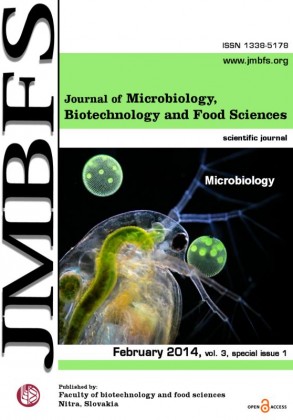PENICILLIUM STRAINS ISOLATED FROM GRAPES GROWN IN THE CENTRAL SLOVAK WINE REGION
Keywords:
Penicillium, wine grapes, TLC method, mycotoxinsAbstract
A total of 10 wine producing grapes were collected from the Central Slovak region in 2011 and 2012, which involved 7 vineyards. Mycological analysis was carried out for the detection of fungi using standard media with focus on genera Penicillium. The exogenous mycobiota was determined by the method of direct placing of berry samples on agar plates and the endogenous mycobiota by the same method but the berry samples were first superficially sterilized. The resulting Penicillia were identified morphologically. The potentially toxigenic isolates were analysed for mycotoxin production by TLC method. In general representatives of Penicillium genus were isolated with higher frequency from the surface of the berries than from their interior. In regard to species Penicillium chrysogenum seems to be the most wide-spread in wine grape berries from the Central Slovak wine growing area because was detected more frequently than other species. In total, 546 fungal isolates belonging to 12 Penicillium species. Overall, two species were dominant: P. chrysogenum and P. expansum. Four potentially toxigenic species isolated from endogenous mycobiota were tested for their toxigenic ability. Out of 10 strains, all of them produced at least one mycotoxin. Of all 16 potentially toxigenic strains from exogenous mycobiota, 88% produced at least one mycotoxin. Therefore study concluded, that wine producing grapes seems to be risk products.Downloads
Download data is not yet available.
Downloads
Published
2014-02-01
How to Cite
Felšöciová, S., Rybárik, ĽubomÃÂr, TanÄinová, D., & MaÅ¡ková, Z. (2014). PENICILLIUM STRAINS ISOLATED FROM GRAPES GROWN IN THE CENTRAL SLOVAK WINE REGION. Journal of Microbiology, Biotechnology and Food Sciences, 3(special issue 1 (Microbiology), 210–214. Retrieved from https://office2.jmbfs.org/index.php/JMBFS/article/view/7607
Issue
Section
Microbiology
License
Copyright (c) 2014 Soňa Felšöciová, ĽubomÃÂr Rybárik, Dana TanÄinová, Zuzana MaÅ¡ková

This work is licensed under a Creative Commons Attribution 4.0 International License.
All papers published in the Journal of Microbiology, Biotechnology and Food Sciences are published under a CC-BY licence (CC-BY 4.0). Published materials can be shared (copy and redistribute the material in any medium or format) and adapted (remix, transform, and build upon the material for any purpose, even commercially) with specifying the author(s).

